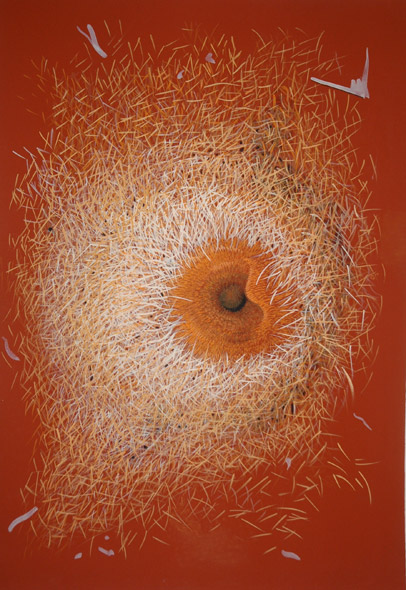Gunderbooka Grey Skies
February 26, 2009 by Draney
Filed under Artist Blog, Recent Art

This image was my first after a long hiatus from painting. I have recently been experimenting with gauche and pastels and found the medium suitable for the way I work. The inspiration for the image came from some photography work I did for National Parks and Wildlife at Bourke.
Gunderbooka Nest
February 26, 2009 by Draney
Filed under Artist Blog, Recent Art

This image is the last of the latest 3 completed during my recent holidays in February. I have always been fascinated by the way the ants around Gunderbooka mountain organize their nest using leaves that have fallen to the ground. This is my second attempt using this subject matter.
The Tucker Box
February 26, 2009 by WebMaster
Filed under Coals Camp Ovens and Cooking, The Tucker Box
If you are a real novice at cooking, then start with something easy like “Burnt Water Stew” for a step by step guide to making a simple stew using only meat and veggies with no added herbs and spices. You will be surprised at the quality of the meal.
Even though we can cook up a storm in the camp oven, using all sorts of herbs and sauces and such, the simple wholesome flavour and the satisfaction of making such an easy tasty recipe never tires.
Here is a suggestion of “Tucker Box” ingredients that would be useful to have with you for making these recipes.
What You Need
- Sense Of Humour
- Plain Flower
- Self Raising Flour
- Corn Flour
- Bread Crumbs
- Corn Crumbs
- Salt
- Sugar
- Mixed herbs
- Garlic
- Tomato Sauce
- Worcestershire Sauce
- Chilli Sauce
- Spuds
- Onions Pumpkin
- Tomatoes
- Tin peas
- Tin corn
- Zucchini
- Lemons
- Meats
As we have said above, most of the meat in this book can be simply bought from any butchers shop. The exceptions are the “Bardi Grubs” and the Yabbies. Advice is given later on how to catch Bardi Grubs. For the yabbies, most fishing shops sell opera house type traps that are built to the specification laws of the Fisheries Department and they are excellent to use. Simply place a bit of meat or a piece of soap into the bait net in the trap and throw into the water. These traps are great for overnight yabby catching expeditions as you can be practicing some camp oven cooking while you wait for the trap to fill.
The other type to use is the “Dilly”, which is looks like a butterfly net without the handle, you just tie your bait in, tie a rope to your trap, and then toss it into the water. Check it every five minutes by lifting straight up quickly and smoothly. Centrifugal force will hold the yabbies in the bottom of the net. These are good for catching yabbies as they don’t take much time to start working. Check the Fisheries Department for numbers of traps and Dillies allowed per person, these figures change now and again.
Aboriginal peoples in this country have eaten Bardi Grubs and the more widely known Witchety Grubs since time began. Our modern day palettes have been educated to be repulsed at the thought of this, however, we can assure you that once the squeamishness is overcome you will find a food source that is not only delicious but extraordinarily high in protein. A relatively small amount can go along way energy wise.
If you use more energy collecting food than you gain in nutritional value by eating it, then I’m afraid you are going to starve to death. This happened to a few of the earlier explorers.
The best way to find Bardi’s is to find a local who knows what he is talking about. No doubt he will be in the local pub, so you will obviously have to do quite a bit of research in the pub on this matter. Basically catching them, though simple enough, is a bit of a bush art and is best learnt by demonstration.
Once a “Bardi Tree” has been found, chip away at the ground surface below until you find the holes. These could be a meter or more in length and will have a fat grub at the bottom. Thread a bit of wire with a little ball of wool tied to the end down the hole until you feel a bit of resistance at the end. This is the grub, just dangle the wool around his face until he gets cranky and grabs it, then in one smooth motion slip him up his tunnel and over your shoulder in one careful pull. It is really impressive to watch some of the old timers doing this, and you will have respect for the craft yourself after you have ripped the heads of half a dozen perfectly good Bardi’s.
Ronnie Wilson
Camp Oven Cleaning & Maintenance
February 26, 2009 by WebMaster
Filed under Camp Oven Cleaning and Maintenance, Coals Camp Ovens and Cooking
When cleaning an oven use newspaper if possible and just keep wiping it out with fresh sheets until clean. This will bring it back to its dull black protective layer without taking it off, then just throw the newspaper into the fire as you go and the washing up is done.If absolutely necessary use warm soapy water and a soft cloth.
Another camp oven cook we know called Tiny, told us a story about his pride and joy. An oven he owned for twenty years and in that time it had never been washed. Well anyway his mate was going camping with the missus one night and he wanted to have a go at cooking a roast in a camp oven and so he borrowed Tiny’s oven. He wasn’t real keen to lend it but he knew these people would look after it and bring it back.
A couple of days later they brought it back all right, with many thank you’s in parting the mate said:
“Oh by the way me an the missus give it a good cleaning for you and I tell you Tiny it was bloody hard work, I ended up getting all that black stuff off though with my angle grinder and now it is good as new”.
Then they drove off in a cloud of dust leaving Tiny standing there with mouth gaping in horror at the loss of twenty years of baked dinners. Sure enough when he lifted the lid he found a bright and shiny new metal surface on his oven.
So put your camp oven on the list with your chainsaw and outboard motor of things that never get lent even to your best mate.
Just remember that a camp oven will not wear out from use only from neglect.
Ronnie Wilson
Camp Oven Cooking
February 26, 2009 by WebMaster
Filed under Camp Oven Cooking, Coals Camp Ovens and Cooking
Cooking by ear is the way to learn because you get to leave the lid on for longer periods of time, which as you can imagine keeps all those lovely flavours where they’re supposed to be, not to mention, heat.
Camp ovens cook with pressure as well as heat and most meals do better cooking slow and longer. The saving grace is that you will probably be camping at the time of cooking and so the ‘near enough’ rule will probably apply.
Residual flavours will linger in your camp oven. The metal is porous and will adopt the flavours that have been given to it. This is one reason camp oven roasts and stews always seem to have that indescribable secret flavour. We always try to throw a roast in our ovens after every couple of stews. This keeps the stored flavour in the oven wall loaded and also keeps a natural oily glaze there to protect the oven surface.
The major exception to this rule is with your breads and dampers. A damper will make an interesting dessert when cooked in a curry-flavoured oven. We have one small oven that we use only for dampers and bread. This just makes certain you don’t end up with unwanted flavours in them.
Ronnie Wilson
Dingo’s Breakfast
February 26, 2009 by WebMaster
Filed under Dingoes Breakfast, Smokos' Snacks and Hangovers
In the swagmans days, often there was little or no tucker in the tucker bags and this is probably where the “Dingo’s Breakfast” originated from.
Basically a Dingo’s Breakfast is to get up at day light, “have a piss and a good look around”, before setting off on your way again.
What you need
- Full bladder
- Empty tucker bags
What you do
Gaze about the bush whilst emptying the bladder.
Tricks & Tips
Whistling is optional.
Rating
Not very nutritious
Billy Tea
February 26, 2009 by WebMaster
Filed under Billy Tea, Smokos' Snacks and Hangovers
What you need
- Tea, Australian grown of course
- Sugar as needed
- Milk as needed
- Water
- “Billy Can”, make your own or buy one
- Forked stick
- Fire
What you do
Drag some coals out of the fire and put the billy on. When boiling, throw in a single fistful of tea for each person and then throw one in for the pot. Leave on heat for another minute then pull away from coals using the forked stick on the handle to lift.
This is where the rot sets in.
Grab billy handle with hat or other suitable insulator and swing quickly around in a full circle three times bringing it back up past your knee then back over your shoulder and so completing a full circle each time. The reason for doing this is to sink the tea leaves to the bottom of the pot so you can pour a drink without filling the cup with tea leaves.
However if you just let it sit for a minute or two and then pour carefully you still get a good cuppa without risking life and limb.
Tricks & Tips
Some people apparently use tea strainers.
Rating
Nothing like a good tin mug of billy tea to start the day, and for smoko drink with a slab of damper in the other hand.
Damper
February 26, 2009 by WebMaster
Filed under Damper, Smokos' Snacks and Hangovers
What you need
- 1kg bag of self raising flour
- Water
- Salt
- Tablespoon of milk powder (optional)
- Tablespoon of icing sugar (optional)
- Raisins or sultanas (optional)
What you do
Put the flour in a bowl large enough to mix in. Mix in half a teaspoon of salt and any or all of the optional ingredients. When dry ingredients are well mixed, add water while cutting mixture with a butter knife. Keep cutting until mixture is evenly wet and resembles dough. With well floured hands, pick up and drop into your already pre heated camp oven, and shovel some coals on to the lid. Check in twenty minutes, should take about thirty minutes give or take a few. Use a piece of fencing wire to spear the damper, if no dough sticks to it when you pull it out then it is cooked.
Tricks & Tips
The milk powder and the icing sugar make the difference between it being a good damper and a bloody legend of a damper. Also try basting the top of the damper with a bit of milk and sprinkle the surface with sesame seeds, hmm yummy.
Rating
Everyone’s favourite.
Jonny Cakes
February 26, 2009 by WebMaster
Filed under Jonny Cakes, Smokos' Snacks and Hangovers
What you need
- 1kg bag of self raising flour
- Water
- Salt
- Chicken wire (or wire grill)
What you do
You will need a flat bed of coals to cook on and no flame. If you don’t have a manufactured flat grill, you will have to fashion one out of chicken wire. Mix a dough the same as you would for damper. Spend some time on it cutting and kneading. This will aerate the dough and give you a lighter bread.
Break off a piece of dough the size of a tennis ball, roll this into a ball shape and then flatten it out to about 1cm thickness. Throw the grill straight on the coals and the Johny cake straight on the grill. The cake will swell and ‘bubble’ when the bottom is cooked, just turn it over and give it about the same time on the other side.
Tricks & Tips
Because the heat will be so direct, the coals don’t need to be that hot. If you have flames on your coals you will definitely burn these.
If you are making your own grill out of wire, use something flat and heavy to get the grill nice and flat.
Rating
It’s a pity you will have to keep this a secret, because everybody would have loved these.
Eskimo Yabbies
February 26, 2009 by WebMaster
Filed under Eskimo Yabbies, Smokos' Snacks and Hangovers
What you need
- Hot day
- Nothing better to do
- Comfy portable chair
- Esky full of beer and ice
- Esky full of fresh caught, boiled yabbies on ice
- Shady tree
What you do
Isn’t it bloody obvious?
Tricks & Tips
Sit as close to the two esky’s as possible so as to conserve energy. Get yourself into a hypnotic yabby peeling beer drinking state and if someone speaks to you either ignore them, or just grunt till they go away.
Rating
Sheer bliss. Wives tend to dislike this one.


